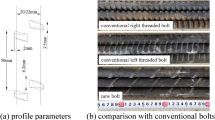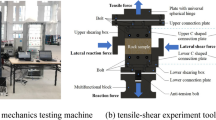Abstract
Bolt supports within stratified strata in coal mines contribute to the unique characteristics of low-buried engineering structures such as tunnels or subways. Failure at the bolt interface is the main trigger of support failure in such settings. This paper comprehensively investigates the serial decoupling mechanism at a resin–rock interface, which is a process that occurs frequently in stratified strata. There are, however, different evolutionary processes that exist at the interface, from a total bonding stage to a plastic bonding stage, a slippage plastic bonding stage, a slippage plastic stage and a total slippage stage, sequentially. These processes accelerate the shortening speed of anchor life, whereupon axial force will fluctuate at each stage and corresponding equations can be derived successfully. Finally, a long-term field monitoring test which verifies the theoretical results and effective measures, such as pregrouting, can be used to prevent serial decoupling. The service life of the bolt system also can be prolonged.














Similar content being viewed by others
Notes
WRR, weak reinforced region.
Abbreviations
- C 0, C 1, C 2 :
-
Constant coefficients
- (0, l s):
-
Decoupling section along the interface
- (l s, l p):
-
Plastic section along the interface
- (l p, l):
-
Full-bonding section along the interface
- l :
-
Total length of bolt–resin interface
- d :
-
Diameter of borehole
- d 0 :
-
Influence diameter around the bolt
- r b, d b :
-
Radius and diameter of bolt
- r 0 :
-
Distance from dead centre to wall of the roadway
- k :
-
Coefficient of rock resistance
- K :
-
Deformation coefficient of interface
- E r :
-
Young’s modulus of rock mass
- E c :
-
Composite Young’s modulus of bolt–resin system (BRS)
- E b, E re :
-
Young’s modulus of bolt (b) and resin (re)
- G r, G re :
-
Shear modulus of rock mass and resin
- Dx, dt :
-
Elementary length of two separated tiny slices taken from bolting system
- du c :
-
Deformation of rock mass because of bolting specific to tiny slice
- du :
-
Free deformation of rock mass without bolting as to tiny slice
- dΔu :
-
Reduced deformation of rock mass due to compressive stress increment
- A :
-
Cross-section area of BRS
- S :
-
Influence area around rock mass due to bolting
- P :
-
Original pretightening force of bolt
- P 0 :
-
Total axial force of BRS as the first plastic section appears
- P x0 :
-
Total axial force of BRS at x as the first plastic section appears
- P 1 :
-
Total axial force of BRS as the first decoupling appears
- P x1 :
-
Total axial force of BRS at x as the first decoupling appears
- P 2 :
-
Total axial force of BRS as the second decoupling appears
- P x2 :
-
Total axial force of BRS at x as the second decoupling appears
- P n :
-
Total axial force of BRS as the nth decoupling appears
- P xn :
-
Total axial force of BRS at x as the nth decoupling appears
- P s :
-
Total axial force of BRS for the full slippage plastic stage
- P xs :
-
Total axial force of BRS at x for the full slippage plastic stage
- P t :
-
Total axial force of BRS with only slippage section existing
- τ b :
-
Ultimate shear stress of bolt–resin interface
- τ r :
-
Ultimate shear stress of resin–rock interface
- τ s :
-
Shear stress at slippage interface
- ν r, ν re :
-
Poisson’s ratio of rock mass and resin
- τ(x):
-
Shear stress at x along the resin–rock interface
- φ :
-
Internal friction angle of resin
- τ 0 :
-
Bonding shear stress at origin
- σ :
-
Axial stress of the bolt at loading point
- α :
-
A constant decided by G r , G re , E b , d, d 0 and d b
- τ t , τ x :
-
Shear stress of interface at t and x
- τ x t :
-
Shear stress of resin–rock interface triggered by τ t at x provided that τ t is bigger than τ x
- τ rx :
-
Total shear stress of resin–rock interface at x
- σ c(t):
-
Axial stress of interface at t
- σ c(x):
-
Axial stress of interface at x
- Δσ :
-
Compressive stress increment in the rock mass, induced by bolting
- εc :
-
Composite strain of BRS
- εr :
-
Strain of rock mass
- τ c1(x):
-
Shear stress of resin–rock interface at x caused by rock’s deformation
- τ c2(x):
-
Shear stress of resin–rock interface at x caused by the pull-out force in the BRS ranging from r 0 to x
References
Ahangari K, Beygi MHA, Rezaei Y (2013) Applicability of fiber reinforced self-compacting concrete for tunnel lining. Arab J Geosci 6(10):3841–3846
Bagheri B, Soltani F, Mohammadi H (2014) Prediction of plastic zone size around circular tunnels in non-hydrostatic stress field. Int J Min Sci Technol 24(1):81–85
BP Statistical Review of World Energy (2013) Statistical review of world energy 2013. Available: http://www.bp.com/en/global/corporate/about-bp/statistical-review-of-world-energy-2013.html. Accessed 16 October 2013
Brady BHG, Brown ET (1993) Rock mechanics for underground mining, 2nd edn. Chapman & Hall, London
Cai Y, Esaki T, Jiang YJ (2004) A rock bolt and rock mass interaction model. Int J Rock Mech Min Sci 41(7):1055–1067
China National Coal Association (CNCA), Xinwen Mining Group of Shandong Energy Group (2013) Mining technology of national thousand-meter-deep coal mines. China University of Mining and Technology Press, Xuzhou
Dadashi E, Ahangari K, Noorzad A, Arab A (2012) Support system suggestion based on back-analysis results case study: Babolak water conveyance tunnel. Arab J Geosci 5(6):1297–1306
Farmer IW (1975) Stress distribution along a resin grouted rock anchor. Int J Rock Mech Min Sci Geomech Abstr 12(11):347–351
Freeman TJ (1978) The behaviour of fully bonded rock bolts in the Kielder experimental tunnel. Tunn Tunn 10(5):37–40
He SM, Li XP (2006) Study on mechanism of prestressed anchor bolt. Chin J Rock Mech Eng 25(9):1876–1880
Hosseini N, Oraee K, Shahriar K, Goshtasbi K (2013) Studying the stress redistribution around the longwall mining panel using passive seismic velocity tomography and geostatistical estimation. Arab J Geosci 6(5):1407–1416
Kilic A, Yasar E, Celik AG (2002) Effect of grout properties on the pull-out load capacity of fully grouted rock bolt. Tunn Undergr Space Technol 17(4):355–362
Meng QB, Han LJ, Qiao WG, Lin DG, Fan JD (2014) Support technology for mine roadways in extreme weakly cemented strata and its application. Int J Min Sci Technol 24(2):157–164
Paul A, Singh AP, Loui PJ, Singh AK, Khandelwal M (2012) Validation of RMR-based support design using roof bolts by numerical modeling for underground coal mine of Monnet Ispat, Raigarh, India—a case study. Arab J Geosci 5(6):1435–1448
Qian MG, Shi PW, Xu JL (2010) Mine pressure and stratum control. China University of Mining and Technology Press, Xuzhou
Shi YW, Zhang ST, Yin SK, Rui SS, Li CX (2009) The stratum control technology for deep coal mining at home and abroad. China Coal Industry Publishing House, Beijing
Shuqi M, Jan N, Naj A (2013) An analytical model of fully grouted rock bolt subjected to tensile load. Contr Build Mater 49:519–526
U.S. Energy Information Administration (2013) Total primary coal production (thousand short tons) of China. Available: http://www.eia.gov/cfapps/ipdbproject/iedindex3.cfm?tid=1&pid=7&aid=1&cid=CH,&syid=2008&eyid=2012&unit=TST. Accessed 16 October 2013
Villaescusa E, Potvin Y (2004) Ground support in mining & underground construction. Taylor & Francis Group plc, London, pp 425–429
Windsor CR (1997) Rock reinforcement systems. Int J Rock Mech Min Sci 34(6):919–951
Xie HP, Peng SP, He MC (2006) Basic theory and engineering practice of deep mining. Science Press, Beijing
You CA, Zhang YB, Liu QY et al (2013) Shear lag-debonding model for anchorage section of prestressed anchor cable. Chin J Rock Mech Eng 32(4):800–806
Zhang N, Zhang NC, Han CL, Qian DY, Xue F (2014) Borehole stress monitoring analysis on advanced abutment pressure induced by longwall mining. Arab J Geosci 7:457–463
Zheng XG (2013) Evolutionary mechanism of bolt’s (cable’s) lift anchoring force and surrounding rock controlling technology of roadway in coalmine. Dissertation, China University of Mining and Technology
Zong YJ, Han LJ, Qu T, Yang S (2014) Mechanical properties and failure characteristics of fractured sandstone with grouting and anchorage. Int J Min Sci Technol 24(2):165–170
Acknowledgments
Financial support for this paper from the National Natural Science Foundation of China (51104152) and Fundamental Research Funds for the Central Universities (2011QNB02) is gratefully acknowledged. We thank the engineering participants in the research project for the installation of bolts and the collection of data underground, their hard work was laudable. In particular, the assistance and suggestions of Dr. Saif ur Rehman and Masters Suresh Sanda, Moshoeshoe Emmanuel Nkuebe in reviewing this paper are particularly appreciated.
Author information
Authors and Affiliations
Corresponding author
Rights and permissions
About this article
Cite this article
Zheng, X., Feng, X., Zhang, N. et al. Serial decoupling of bolts in coal mine roadway supports. Arab J Geosci 8, 6709–6722 (2015). https://doi.org/10.1007/s12517-014-1697-z
Received:
Accepted:
Published:
Issue Date:
DOI: https://doi.org/10.1007/s12517-014-1697-z




